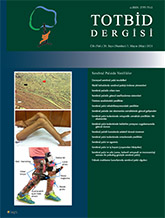
Early diagnosis and early treatment in cerebral palsy patients are very important for the development of the nervous system to continue its natural development. Studies about the onset and management of this disease should be sufficiently detailed and the cause/effect relationship should be determined. Experimentally cerebral palsy animal models are open to innovations in mimicking the disease in humans. Although cerebral palsy is determined as a single diagnosis, the variety and association of existing pathologies complicate the formation mechanism of the disease. Many mechanisms such as prematurity, white matter damage, hypoxic-ischemic encephalopathy, perinatal infections, cerebral artery occlusions, intrauterine infections, cerebral hemorrhages, and genetic predispositions may play a role in the formation of cerebral palsy. In our study; practicing pathological mechanisms in animal experiments and correlation of results with human cerebral palsy disease, injury mechanisms and differences between species will be evaluated. Recent studies contain valuable information about; early diagnosis, prevention of the disease, reducing symptoms, possible treatment options. Thus, our knowledge is important in terms of providing an idea for future studies.